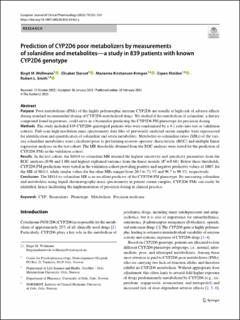| dc.contributor.author | Wollmann, Birgit Malene Tovik | |
| dc.contributor.author | Størset, Elisabet | |
| dc.contributor.author | Kringen, Marianne K. | |
| dc.contributor.author | Molden, Espen | |
| dc.contributor.author | Smith, Robert Løvsletten | |
| dc.date.accessioned | 2024-01-04T07:43:29Z | |
| dc.date.available | 2024-01-04T07:43:29Z | |
| dc.date.created | 2023-06-08T14:02:23Z | |
| dc.date.issued | 2023 | |
| dc.identifier.citation | European Journal of Clinical Pharmacology. 2023, 79 (4), 523-531. | en_US |
| dc.identifier.issn | 0031-6970 | |
| dc.identifier.uri | https://hdl.handle.net/11250/3109680 | |
| dc.description.abstract | Purpose Poor metabolizers (PMs) of the highly polymorphic enzyme CYP2D6 are usually at high risk of adverse effects
during standard recommended dosing of CYP2D6-metabolized drugs. We studied if the metabolism of solanidine, a dietary
compound found in potatoes, could serve as a biomarker predicting the CYP2D6 PM phenotype for precision dosing.
Methods The study included 839 CYP2D6-genotyped patients who were randomized by a 4:1 ratio into test or validation
cohorts. Full-scan high-resolution mass spectrometry data files of previously analyzed serum samples were reprocessed
for identification and quantification of solanidine and seven metabolites. Metabolite-to-solanidine ratios (MRs) of the vari-
ous solanidine metabolites were calculated prior to performing receiver operator characteristic (ROC) and multiple linear
regression analyses on the test cohort. The MR thresholds obtained from the ROC analyses were tested for the prediction of
CYP2D6 PMs in the validation cohort.
Results In the test cohort, the M414-to-solanidine MR attained the highest sensitivity and specificity parameters from the
ROC analyses (0.98 and 1.00) and highest explained variance from the linear models (R2 = 0.68). Below these thresholds,
CYP2D6 PM predictions were tested in the validation cohort providing positive and negative predictive values of 100% for
the MR of M414, while similar values for the other MRs ranged from 20.5 to 73.3% and 96.7 to 99.3%, respectively.
Conclusion The M414-to-solanidine MR is an excellent predictor of the CYP2D6 PM phenotype. By measuring solanidine
and metabolites using liquid chromatography-mass spectrometry in patient serum samples, CYP2D6 PMs can easily be
identified, hence facilitating the implementation of precision dosing in clinical practice. | en_US |
| dc.language.iso | eng | en_US |
| dc.rights | Navngivelse 4.0 Internasjonal | * |
| dc.rights.uri | http://creativecommons.org/licenses/by/4.0/deed.no | * |
| dc.title | Prediction of CYP2D6 poor metabolizers by measurements of solanidine and metabolites—a study in 839 patients with known CYP2D6 genotype | en_US |
| dc.type | Peer reviewed | en_US |
| dc.type | Journal article | en_US |
| dc.description.version | publishedVersion | en_US |
| cristin.ispublished | true | |
| cristin.fulltext | original | |
| cristin.qualitycode | 2 | |
| dc.identifier.doi | 10.1007/s00228-023-03462-y | |
| dc.identifier.cristin | 2153097 | |
| dc.source.journal | European Journal of Clinical Pharmacology | en_US |
| dc.source.volume | 79 | en_US |
| dc.source.issue | 4 | en_US |
| dc.source.pagenumber | 523-531 | en_US |

